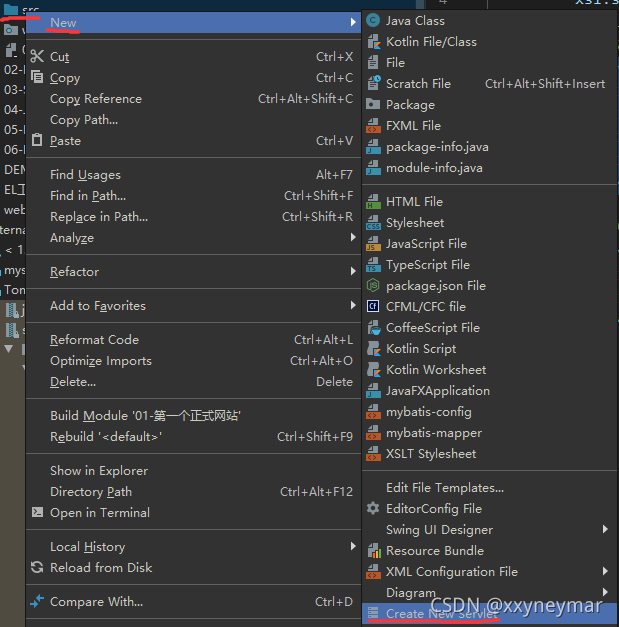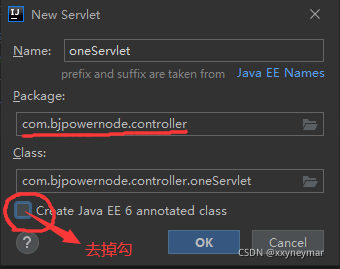目录
1.概述
? ?servlet规范来自于JavaEE规范中的一种。
? ?作用:
? ? ? ? ①在Servlet规范中,指定动态资源文件开发步骤
? ? ? ? ②在Servlet规范中,指定Http服务器调用动态资源文件规则
? ? ? ? ③在Servlet规范中,指定Http服务器管理动态资源文件实例对象规则
2.Servlet接口实现类的开发步骤
2.1 Servlet接口实现类
? ?Servlet接口来自于Servlet规范下的一个接口,这个接口存在Http服务器提供的jar包内。
? ?Tomcat服务器下的lib文件夹中有一个servlet-api.jar存放Servlet接口(javax.servlet.Servlet接口)。
? ?Servlet规范中认为Http服务器能调用的动态资源文件必须是一个Servlet接口实现类。
2.2 Servlet接口实现类开发步骤
? ?①创建一个java类继承于HttpServlet父类(servlet-api.jar包内,javax.servlet.http.HttpServlet抽象类,而该类继承了GenericServlet抽象类,该父类实现了Servlet接口),使之成为一个Servlet接口实现类。
? ? ? ? 为什么不直接继承Servlet接口?
? ? ? ? ? ? ? ? 因为Servlet接口很多方法我们不需要使用,一般只需要使用到service()方法,因此通过
??????????????继承其他该接口的实现类,可以减少我们需要重写的方法数量。抽象类的作用就是降低接
??????????????口实现类对接口的实现难度,将接口中不需要使用的抽象方法交给抽象类进行完成,这样
??????????????接口实现类只需要对接口中需要使用的方法进行重写。
? ? ? ? Servlet接口中的方法:
? ? ? ? ? ? ? ? 1.init()
? ? ? ? ? ? ? ? 2.getServletConfig()
? ? ? ? ? ? ? ? 3.getServeltInfo()
? ? ? ? ? ? ? ? 4.destory()
? ? ? ? ? ? ? ? 5.service()
? ? ? ? Tomcat根据Servlet规范调用Servlet接口实现类的规则:
? ? ? ? ? ? ? ? 1.Tomcat有权自动创建Servlet接口实现类实例对象
? ? ? ? ? ? ? ? ? ? ? ? Servlet oneServlet = new OneServlet();
? ? ? ? ? ? ? ? 2.Tomcat根据实例对象调用service方法处理当前请求
? ? ? ? ? ? ? ? ? ? ? ? oneServlet.service();
? ? ? ? 各个类的关系:
????????????????oneServlet? ?extends? ?(abstract)HttpServlet? ?entends (abstract)GenericServlet? ????????????????????????????????????????????????????????????????????????????????????????implements Servlet接口
? ? ? ? ? ? ? ? 其中GenericServlet抽象类中实现了Servlet接口中我们不需要用到的四个方法:init()、
??????????????getServletConfig()、getServletInfo()、destory()。?
? ? ? ? ? ? ? ? HttpServlet抽象类中实现了service()方法。
? ? ? ? ? ? ? ? 自己定义的子类均可以继承这五个实现后的方法。
? ?②重写HttpServlet父类中的两个方法,doGet()、doPost()。如果浏览器发送请求的方式为get,则调用的是doGet()方法;如果发送请求的方式为post,则调用的是doPost()方法。
protected void doGet(HttpServletRequest req, HttpServletResponse resp) throws ServletException, IOException{}
protected void doPost(HttpServletRequest req, HttpServletResponse resp) throws ServletException, IOException{} ? ? ? ? 在HttpServlet抽象类中实现的service()方法会根据浏览器请求的方式来调用doGet()或
??????doPost()方法。这种通过父类决定何种情况下调用子类中方法,是设计模式中的模板设计模
??????式。
protected void service(HttpServletRequest req, HttpServletResponse resp) throws ServletException, IOException {
String method = req.getMethod();
long lastModified;
if (method.equals("GET")) {
lastModified = this.getLastModified(req);
if (lastModified == -1L) {
this.doGet(req, resp);//调用子类中的doGet()方法
} else {
long ifModifiedSince;
try {
ifModifiedSince = req.getDateHeader("If-Modified-Since");
} catch (IllegalArgumentException var9) {
ifModifiedSince = -1L;
}
if (ifModifiedSince < lastModified / 1000L * 1000L) {
this.maybeSetLastModified(resp, lastModified);
this.doGet(req, resp);
} else {
resp.setStatus(304);
}
}
} else if (method.equals("HEAD")) {
lastModified = this.getLastModified(req);
this.maybeSetLastModified(resp, lastModified);
this.doHead(req, resp);
} else if (method.equals("POST")) {
this.doPost(req, resp);//调用子类中的doPost()方法
} else if (method.equals("PUT")) {
this.doPut(req, resp);
} else if (method.equals("DELETE")) {
this.doDelete(req, resp);
} else if (method.equals("OPTIONS")) {
this.doOptions(req, resp);
} else if (method.equals("TRACE")) {
this.doTrace(req, resp);
} else {
String errMsg = lStrings.getString("http.method_not_implemented");
Object[] errArgs = new Object[]{method};
errMsg = MessageFormat.format(errMsg, errArgs);
resp.sendError(501, errMsg);
}
}? ?③将Servlet接口实现类注册到Tomcat服务器。
? ? ? ? 网站--->web文件夹--->WEB-INF文件夹--->web.xml文件
<?xml version="1.0" encoding="UTF-8"?>
<web-app xmlns="http://xmlns.jcp.org/xml/ns/javaee"
xmlns:xsi="http://www.w3.org/2001/XMLSchema-instance"
xsi:schemaLocation="http://xmlns.jcp.org/xml/ns/javaee http://xmlns.jcp.org/xml/ns/javaee/web-app_4_0.xsd"
version="4.0">
<!--Servlet接口实现类路径地址交给Tomcat-->
<servlet>
<servlet-name>oneServlet</servlet-name><!--声明一个遍历存储Servlet接口是西安类的类路径-->
<!--suppress WebProperties -->
<servlet-class>com.bjpowernode.controller.OneServlet</servlet-class><!--Servlet接口实现类路径-->
</servlet>
<!--为Servlet接口实现类提供一个简短的别名,降低用户访问Servlet接口实现类难度-->
<servlet-mapping>
<servlet-name>oneServlet</servlet-name>
<url-pattern>/one</url-pattern><!--设置简短请求别名,别名在书写时必须以"/"开头-->
</servlet-mapping>
</web-app>3.Servlet对象的生命周期
? ?1.网站中所有Servlet接口实现类的实例对象,只能由Http服务器负责创建,开发人员不需要手动创建Servlet接口实现类的实例对象。
? ?2.在默认的请求下,Http服务器接收到对于当前Servlet接口实现类第一次请求时自动创建这个Servlet接口实现类的实例对象。
? ?在手动配置情况下,要求Http服务器在启动时自动创建某个Servlet接口实现类的实例对象,在向服务器注册该类时,加上一句:
<servlet>
<servlet-name>oneServlet</servlet-name>
<!--suppress WebProperties -->
<servlet-class>com.bjpowernode.controller.OneServlet</servlet-class>
<load-on-startup>30</load-on-startup><!--填写一个大于0的整数即可-->
</servlet>? ?3.在Http服务器运行期间,一个Servlet接口实现类只能被创建出一个实例对象。多个用户访问时,也只有一个实例对象,相当于一个进程多个线程。
? ?4.在Http服务器关闭时刻,自动将网站中所有的Servlet对象进行销毁。
? ?IDEA快速创建Servlet接口的实现类:


4.HttpServletResponse接口
4.1 介绍
? ?①HttpServletResponse接口来自于Servlet规范中,在Tomcat中存在于servlet-api.jar包中。
? ?②HttpServletResponse接口实现类由http服务器负责提供
? ?③HttpServletResponse接口负责将doGet/doPost方法执行结果写入到响应体交给浏览器
? ?④开发人员习惯于将HttpServletResponse接口修饰的对象称为响应对象。
4.2 主要功能
? ?①将执行结果以二进制形式写入到响应体
? ?②设置响应头中content-type属性值,从而控制浏览器使用对应编译器将响应体二进制数据编译为文字、图片、视频、命令
? ?③设置响应头location属性,将一个请求地址赋值给location,从而控制浏览器向指定服务器发送请求
4.3 实例
? ?1.通过HttpServletResponse接口实现类对象response获得需要的输出流。
public class OneServlet extends HttpServlet {
protected void doGet(HttpServletRequest request, HttpServletResponse response) throws ServletException, IOException {
String result = "Hello World";//执行结果
//---------响应对象将结果写入响应体----------start
//1.通过响应对象,向Tomcat索要输出流
PrintWriter out = response.getWriter();
//2.通过输出流,将执行结果以二进制形式写入到响应体
out.write(result);
//不是自己创建的输出流,不需要自己手动关闭
//---------响应对象将结果写入响应体----------end
}
//doGet方法执行完毕
//Tomcat将响应包推送给浏览器
}? ?2.out.print()方法:
/**
* 问题描述:浏览器接受到数据是2,不是50
* 问题原因:
* out.write方法可以将“字符”,“字符串”,“ASCII码”写入到响应体
* 参数放入数字,计算机认为是ASCII码,而2的ASCII码就是50
*
* 解决方法:实际开发中,都是通过out.print()将真实数据写入到响应体
*
*/
public class TwoServlet extends HttpServlet {
protected void doGet(HttpServletRequest request, HttpServletResponse response) throws ServletException, IOException {
int money = 50;
PrintWriter out = response.getWriter();
//out.write(money);
out.print(money);//以后都使用这个方法即可
}
}? ?3.通过设置context-type属性来控制浏览器的编译格式。默认情况下context-type属性的值为"test"
/**
* 问题描述:Java<br>Mysql<br>Html
* 浏览器在接收到响应结果时,将<br>作为文字内容在窗口展示出来,没有将<br>当作HTML标签命令来执行
*
* 问题原因:
* 浏览器在接收到响应包之后,根据响应头中的content-type属性的值,
* 来采用对应的编译器对响应体中二进制内容进行编译处理。
*
* 在默认情况下,content-type属性的值为test 即content-type="test"
* 此时浏览器会采用文本编辑器对响应体二进制数据进行解析。
*
* 解决方案:
* 一定要在得到输出流之前,通过响应对象响应头中content-type属性进行一次重新赋值
* 用于制定浏览器采用正确编译器。
*/
public class ThreeServlet extends HttpServlet {
protected void doGet(HttpServletRequest request, HttpServletResponse response) throws ServletException, IOException {
String result = "Java<br>Mysql<br>Html";//既有文字信息,又有HTML标签命令
String result2 = "<br>红烧排骨<br>梅菜肘子<br>糖醋里脊";
//在获得输出流之前,设置content-type属性
response.setContentType("text/html;charset=utf-8");
PrintWriter out = response.getWriter();
out.print(result);
out.print(result2);
}
}
? ?4.设置location属性设置响应头,向其他服务器发起请求。
public class FourServlet extends HttpServlet {
protected void doGet(HttpServletRequest request, HttpServletResponse response) throws ServletException, IOException {
String result = "http://www.baidu.com";
//通过响应对象,将地址赋值给响应头中location属性
response.sendRedirect(result);//[响应头 location="http://www.baidu.com"]
}
/**
* 浏览器在接收到响应包之后,如果发现响应头中存在location属性,自动通过地址栏location指定网站发送请求
*
* sendRedirect方法远程控制浏览器请求行为【请求地址,请求方式,请求参数】
*/
}5.HttpServletRequest接口
5.1 介绍
? ?①HttpServletRequest接口来自于Servlet规范中,在Tomcat中存在于servlet-api.jar包中。
? ?②HttpServletRequest接口实现类由http服务器负责提供
? ?③HttpServletRequest接口负责在doGet/doPost方法运行时读取Http请求协议包中的信息。
? ?④开发人员习惯于将HttpServletRequest接口修饰的对象称为请求对象。
5.2 功能
? ?①可以读取Http请求协议包中请求行信息
? ?②可以读取保存在Http请求协议包中请求头或者请求体中请求参数信息
? ?③可以代替浏览器向Http服务器申请资源文件调用
5.3 实例
? ?1.读取请求行信息。
? ? ? ? URI:资源文件精准定位地址,在请求行没有uri这个属性。实际上uri是url中截取的一个字符
??????串,这个字符串格式"/网站名/资源文件名",uri用于让Http服务器对被访问的资源文件进行定
? ? ? 位。
public class OneServlet extends HttpServlet {
protected void doGet(HttpServletRequest request, HttpServletResponse response) throws ServletException, IOException {
//1.通过请求对象,读取请求行中url信息
String url = request.getRequestURL().toString();
//2.通过请求对象,读取请求行中method信息
String method = request.getMethod();
System.out.println("URL = " + url);
System.out.println("method = " + method);
//3.通过请求对象,读取请求行中uri信息
/**
* URI:资源文件精准定位地址,在请求行并没有URI这个属性。
* 实际上是URL中截取的一个字符串,这个字符串格式"/网站名/资源文件名"
* URI用于让Http服务器对被访问的资源文件进行定位
*/
String uri = request.getRequestURI();
System.out.println("URI = " + uri);
}
}? ?2.读请求头里面的值(get方法)
<!DOCTYPE html>
<html lang="en">
<head>
<meta charset="UTF-8">
<title>Title</title>
</head>
<body>
<center>
<!--利用一个超链接来输入请求参数-->
<a href="/05_HttpServletRequest_war_exploded/two?usernmae=milk&password=123">通过超链接访问TwoServlet并且携带请求参数</a>
</center>
</body>
</html>public class Two1Servlet extends HttpServlet {
protected void doGet(HttpServletRequest request, HttpServletResponse response) throws ServletException, IOException {
//1.通过请求对象获得请求头中所有请求参数名
Enumeration paramNames = request.getParameterNames();//将所有请求参数名称保存到一个枚举对象进行返回
while(paramNames.hasMoreElements()){
String paramName = (String)paramNames.nextElement();
System.out.println("请求参数: " + paramName);
//2.通过请求对象读取指定的请求参数的值
String value = request.getParameter(paramName);
System.out.println("value: " + value);
}
}
}? ?3.读请求体里面的值(post方法)
<!DOCTYPE html>
<html lang="en">
<head>
<meta charset="UTF-8">
<title>Title</title>
</head>
<body>
<center>
<form action="/05_HttpServletRequest_war_exploded/three" method="get">
请求参数:<input type="text" name="userName"/><br>
<input type="submit" value="get方式访问ThreeServlet"/>
</form>
<form action="/05_HttpServletRequest_war_exploded/three" method="post">
请求参数:<input type="text" name="userName"/><br>
<input type="submit" value="post方式访问ThreeServlet"/>
</form>
</center>
</body>
</html>/**
* 问题:
* 以GET方式发送中文参数内容“张三”时,可以得到正常结果
* 以POST方式发送中文参数内容时,得到一堆乱码?????
*
* 原因:
* 浏览器以GET方式发送请求时,请求参数保存在请求头内,在Http请求协议包到达Http服务器之后,第一件事就是进行解码,
* 请求头二进制内容由Tomcat负责解码,Tomcat9.0默认使用utf-8字符集,可以解释一切国家文字。
*
* 浏览器以POST方式发送请求,请求参数保存在请求体内,在Http请求协议包到大Http服务器之后,第一节是就是进行解码,
* 请求体二进制内容由当前请求对象request负责解码。request默认使用[ISO-8859-1]字符集,一个东欧语系字符集,
* 此时如果请求体参数内容是中文,将无法解码,只能得到乱码
*
* 解决方案:
* 在POST请求方式下,读取请求体的内容之前,应该通知请求对象使用utf-8字符集对请求体内容进行一次重新解码。
*/
public class ThreeServlet extends HttpServlet {
protected void doPost(HttpServletRequest request, HttpServletResponse response) throws ServletException, IOException {
//通知请求对象使用utf-8字符集
request.setCharacterEncoding("utf-8");
//通过请求对象,读取请求体中参数信息
Enumeration paramNames = request.getParameterNames();
while (paramNames.hasMoreElements()){
String paramName = (String) paramNames.nextElement();
String value = request.getParameter(paramName);
System.out.println("从请求体得到参数值 " + value);
}
}
protected void doGet(HttpServletRequest request, HttpServletResponse response) throws ServletException, IOException {
//通过请求对象,读取请求头参数信息
String value = request.getParameter("userName");
System.out.println("从请求头的到参数值:" + value);
}
}? ? ? ? ①当浏览器以GET方式发送请求时,请求参数保存在请求头,在Http请求协议包到达Http服务
? ? ? ? ? 器之后,第一件事就是进行解码。请求头二进制内容由Tomcat负责解码,Tomcat9.0默认使
? ? ? ? ? 用UTF-8字符集,可以解释一切国家语言。?
? ? ? ? ②当浏览器以POST方式发送请求时,请求参数保存在请求体,在Http请求协议包到达Http服
? ? ? ? ? 务器之后,第一件事就是进行解码。请求体二进制内容由当前请求对象request负责解码,
? ? ? ? ? request默认使用ISO-8859-1字符集,一个东欧语系字符集,此时如果请求体参数内容是中
? ? ? ? ? 文,将无法正常解码,只能获得乱码。
6.请求对象与响应对象的生命周期
? ?①在Http服务器接收到浏览器发送的Http请求协议包之后,自动为当前的Http请求协议包生成一个请求对象和一个响应对象。
? ?②在Http服务器调用doGet/doPost方法时,负责将请求对象和响应对象作为实参传递到方法,确保doGet/doPost方法正确执行。
? ?③在Http服务器准备推送Http响应协议包之前,负责将本次请求关联的请求对象和响应对象销毁。
? ?请求对象和响应对象生命周期贯穿一次请求的处理过程中。
? ?请求对象和响应对象相当于用户在服务端的代言人。

7.欢迎资源文件
? ?用户一般可以记住网站名,但记不住网站资源名。因此产生了默认欢迎资源文件。
? ?默认欢迎资源文件:用户发送了一个针对某个网站的默认请求时,此时由Http服务器自动从当前网站返回的资源文件。
? ? ? ? 正常请求:http://localhost:8080/myWeb/index.html
? ? ? ? 默认请求:http://localhost:8080/myWeb/
? ?Tomcat服务器对于默认欢迎资源文件的定位规则:
? ? ? ? ①规则位置:Tomcat安装位置/conf/web.xml
? ? ? ? ②定义语法:

? ?设置当前网站的默认欢迎资源文件的规则:
? ? ? ? ①规则位置:网站/web/WEB-INF/web.xml
? ? ? ? ②定义语法:在web.xml文件中添加。

? ? ? ? ③网站设置自定义默认文件定位规则后,此时Tomcat自带定位规则将失效。
PS:根据动力节点课程整理,如有侵权,联系删除。